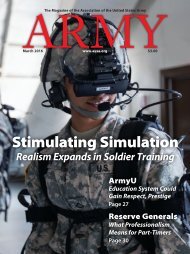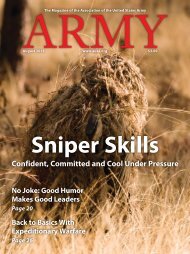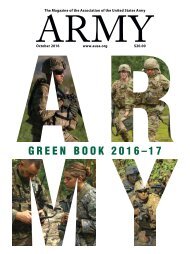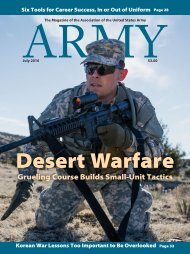Army - Kicking Tires On Jltv
You also want an ePaper? Increase the reach of your titles
YUMPU automatically turns print PDFs into web optimized ePapers that Google loves.
Then-Lt. Gen. Matthew B. Ridgway, commander of Eighth <strong>Army</strong>, inspects<br />
front-line positions in March 1951.<br />
Lt. Gen. Daniel P. Bolger, USA Ret., was the commander of<br />
Combined Security Transition Command-Afghanistan and<br />
NATO Training Mission-Afghanistan. Previously, he served<br />
as the deputy chief of staff, G-3/5/7, and as the commanding<br />
general, 1st Cavalry Division/commanding general, Multinational<br />
Division-Baghdad, Operation Iraqi Freedom. He holds<br />
a doctorate in Russian history from the University of Chicago<br />
and has published a number of books on military subjects. He is<br />
a senior fellow of the AUSA Institute of Land Warfare.<br />
ing a horrific running gunfight on Nov. 30, 1950. A lot of<br />
them made it out, but they left behind 65 blackened cannons;<br />
dozens of shot-up trucks; and far more disturbing, hundreds<br />
of men dead, wounded and lost. The rear guard, the doomed<br />
2nd Engineer Battalion, lost 711 of the 977 soldiers assigned.<br />
In a final act of desperation, the exhausted engineers burned<br />
their colors rather than have them end up as trophies in some<br />
Chinese dayroom. The bugout had been total and bloody.<br />
Yet not all had gone wrong. By careful reconnaissance, securing<br />
the high ground and marching rapidly, the 23rd Infantry<br />
Regimental Combat Team (RCT) avoided the Chinese gauntlet<br />
of fire at Kunu-ri. Tall, thoughtful Col. Paul L. Freeman Jr.<br />
(who would later become a four-star general) had been an adviser<br />
to Chinese forces in World War II. Because he spoke Chinese,<br />
he often questioned prisoners himself. Freeman understood<br />
that the Chinese planned well and executed violently. But<br />
they did not adapt well to the unexpected. Rather than take the<br />
obvious road south, Freeman’s team made it out of the Chinese<br />
trap by going west over a scratch route. It was a smart call.<br />
Afew levels up in the hierarchy, the new Eighth <strong>Army</strong><br />
commander noticed. Then-Lt. Gen. Matthew B. Ridgway<br />
learned how to fight as a paratrooper in World War II.<br />
He had also served in China in 1925–26 and thus, knew<br />
something about the opposing side in Korea. They were good,<br />
but they weren’t 10 feet tall. Ridgway believed that American<br />
soldiers could beat the Chinese if they were well-led. He had<br />
no intention of backing up. “There will be no more discussion<br />
of retreat,” he growled. He meant it. And he kept his eye on<br />
this man Freeman and the 23rd Infantry RCT.<br />
Fifty miles south of the 38th Parallel, the prewar border,<br />
Ridgway’s shaky Eighth <strong>Army</strong> stopped pulling back. Chinese<br />
Communist forces hovered a few ridgelines to the north,<br />
largely out of contact, no doubt getting ready for another offensive.<br />
Taking advantage of the break in the action, undeterred<br />
by the howling wind and snow squalls, Ridgway<br />
roamed the front. He didn’t talk to just corps and division<br />
commanders but spent a lot of time at regimental, battalion<br />
and company level, spreading the new gospel: “Find them! Fix<br />
them! Fight them! Finish them!” He then insisted on training<br />
to reinforce that message. Training in combat? Some of the<br />
officers were amazed. But the tough old sergeants got it immediately.<br />
Training for close combat, for killing Chinese, became<br />
the norm. Bugout was not in the cards anymore.<br />
When the Chinese attacked again in February 1951, Ridgway’s<br />
Eighth <strong>Army</strong> was ready. American artillery and airpower<br />
wreaked havoc on Chinese columns exposed on the<br />
slopes of treeless, snow-covered valleys. Some U.S. units bent.<br />
None broke. But when the Chinese paused to resupply, Freeman’s<br />
tough, veteran 23rd Infantry RCT was isolated well forward<br />
in a perimeter defense, a rough oval about a mile or so<br />
across, anchored on a set of low hills around a dot on the map<br />
called Chipyong-ni. When the division and corps commander<br />
suggested pulling back, Ridgway made it clear that wasn’t going<br />
to happen. Those days were over. Freeman told his subordinates<br />
the deal: “We’re going to stay here and fight it out.”<br />
Freeman’s soldiers dug in, chipping away at the frozen dirt.<br />
They sighted machine guns along mazes of barbed-wire entanglements.<br />
Hundreds of mines were buried as well as 55-<br />
gallon drums of fougasse: fire bombs ready to be triggered on<br />
command. Artillery and mortars registered on key targets,<br />
from distant hills to spots right on the wire. Freeman’s three<br />
battalions held the north, east and south. An attached French<br />
battalion—an all-star team led by a lieutenant general serving<br />
under the nom de guerre of Lt. Col. Ralph Monclar—defended<br />
to the west. Freeman’s 5,400 troops faced five understrength<br />
Chinese divisions, about 30,000 men or so. To even<br />
the odds, Ridgway promised plenty of supporting airstrikes,<br />
aerial resupply drops, and a relieving force to break through<br />
once the Chinese attacked. Well, maybe, but that depended<br />
on the reinforced 23rd Infantry RCT holding its ground.<br />
For 10 days, Freeman’s soldiers dug and kept watch. Early<br />
on Feb. 13, patrols brought word that the Chinese were massing<br />
their forces in the next valley over. As the weak winter sun<br />
set, the Americans and French buttoned up their perimeter.<br />
The French laughed and joked, passing around wine bottles.<br />
After dark, the Chinese probed from the west. They had<br />
found the French. Maybe the enemy thought the language<br />
U.S. <strong>Army</strong><br />
58 ARMY ■ February 2016

















